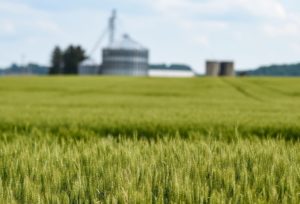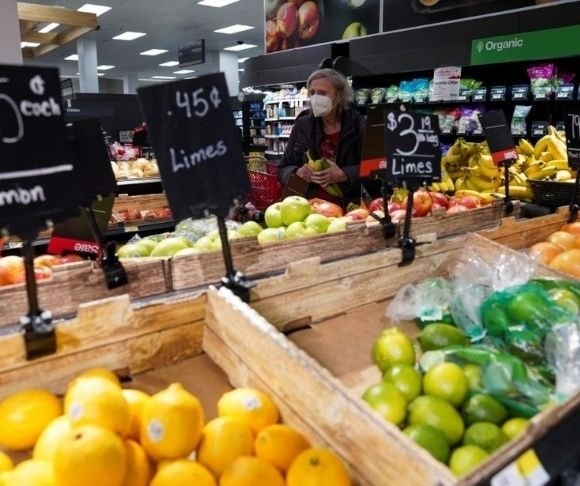To start suppressing your appetite, is it time to drink a cup of black liquid euphemistically referred to as coffee? Perhaps a can of beans and a baked potato will fill you up more quickly. Or maybe adopting a breatharian lifestyle will cut your grocery bill by 100%. Food inflation could spiral out of control as soaring energy prices, Russia’s invasion of Ukraine, and the global supply chain crisis exacerbate an already fragile situation. But while America might fill up on bread, analysts warn that food insecurity could be a sensitive issue across the globe, potentially resulting in political and social upheaval.
Hot Commodities

(Photo by Ben Hasty/MediaNews Group/Reading Eagle via Getty Images)
Wheat is trading north of $12 a bushel. Soybeans are above $16 per bushel. Corn is flirting with $8 a bushel. Coffee, orange juice, cocoa, live cattle, and other agricultural products are climbing to levels unseen in years. Even palm and sunflower oil prices are surging. Is this the commodities supercycle that Liberty Nation wrote about last year? While it is evident that the Ukraine-Russia military conflict has pushed up the price of commodities, from food to energy to metals, the invasion merely exacerbated the troubles that seeped into the marketplace. And this is having an impact on household grocery budgets.
The UN Food and Agriculture Organization (FAO) reported that the Food Price Index surged to a record high of 140.7 points in February, up 3.9% from January and 20.7% from the same time a year ago. In addition, the index witnessed increases for nearly every sub-index, including dairy, cereals, meat, and vegetables. The only category that declined was sugar.
The Bureau of Labor Statistics’ (BLS) food index hit 7% in January. Economists anticipate another jump in food prices in the February data, leaving many vulnerable people struggling to keep up with the growing costs of putting a meal on the table. The US Department of Agriculture (USDA) is forecasting that the overall cost of food will rise as much as 3.5% this year.
Over the last year, as the global economy reopened, consumers, businesses, and governments were demanding everything at the same time. Indeed, output has failed to satisfy demand, while inventories continue to shrink. The worldwide supply chain crisis has exacerbated problems plaguing the international food market. When you add in the Ukraine-Russia war, a real mess requires clean-up in aisle three.
“Both Ukraine and Russia are also called the global breadbasket, and food prices are also likely to surge,” wrote Carsten Brzeski, the Global Head of Macro at ING, in a research note.
Meanwhile, the strife in Eastern Europe contributes to the enormous surge in crude oil and natural gas prices. Yes, this adds to the cost of producing and transporting meat, fruit, and vegetables. But it is also responsible for the dramatic increase in fertilizer prices, an upward trend that is costing farmers a massive amount of money to grow corn, wheat, and soybeans. To put this into perspective, nitrogen fertilizer had spiked 29% in one week on the Green Markets index in the aftermath of Russia invading Ukraine. This has led to a vast rally in fertilizer stocks, like Agrium and Nutrien.
One of the top markets for fertilizer? Russia. What’s worse, Moscow is urging domestic producers to suspend exports. For an international marketplace that had witnessed tight supplies before the war, this is bad news for nearly everyone, and it is going to get only worse as trade flows get interrupted.
 The U.S. government is once again targeting fertilizer producers and farm supplies, warning against price gouging. Like the administration’s complaints against mom-and-pop gasoline stations and Big Meat, the White House’s insinuation is unfounded. But that will unlikely stop Washington from trying to find scapegoats for an issue that has been festering for the last year.
The U.S. government is once again targeting fertilizer producers and farm supplies, warning against price gouging. Like the administration’s complaints against mom-and-pop gasoline stations and Big Meat, the White House’s insinuation is unfounded. But that will unlikely stop Washington from trying to find scapegoats for an issue that has been festering for the last year.
Ben Riensche, an Iowa farmer, might have said it best when he recently told Bloomberg: “You’re gonna have a stunning reality.”
The Sky’s the Limit
How high could food prices go? It might be hard to put a number on it, but market experts recommend getting prepared to allocate more of your monthly budget to your grocery bill. The crisis in Eastern Europe is leading to higher energy and food costs, but even before that situation unfolded, price inflation at the supermarket was still a real threat to the living standards of millions of Americans. But when many countries worldwide have been going through a devastating food crisis throughout the pandemic, from Afghanistan to Lebanon to Syria, this could result in a global tragedy. And not even the quantitative tightening (QT) efforts employed by central banks in every economy on the planet will prevent the growing likelihood of political and social chaos in advanced and developing markets.
~ Read more from Andrew Moran.




